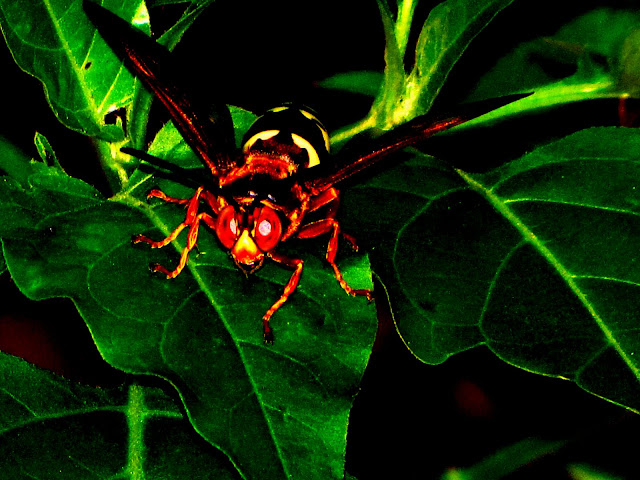The Giant Killer Bees Are Gathering and Preparing For The August Hunt. A Great Bee To See.
Come On In, Take a Nature Break.
How Hot Is It? by:brendasue
Welcome Everyone. I wonder if it is Hot everywhere? Hopefully you are somewhere cool at your computer where you can chill out and look at these Big Bees! I just love them and look forward to them returning every year in July. You do not have to worry about them killing You (unless you are a cicada)!
Flight Deck Command Center by: brendasue
Here you can see the real size of this Bee in flight over the deck. They all pick out a corner to 'guard' as their spot.
Perfect Dirt Landing by: brendasue
This is named a Cicada Killer. They have come here for the big Cicada Hunt that starts anyday now. These bees make tunnels in the sand exactly big enough for the bee and his prey to fit in the opening. They dig very fast using all legs and scooping the sand out of the hole to a mound. Only the females gather the cicada. Only the females can sting. The males are nectar feeders.
Cicada Killer Wasp by: brendasue
Let the Class Begin!
My Leaf by: brendasue
Here you can see our killer bee on 'his' leaf that he has chosen to defend. He looks back and forth, up and down, for other bee intruders. (He is not concerned with me, the camera or the dogs).
This plant is named a four o'clock so that should give you a reference of the size of the leaf. This is the largest bee I have ever seen. (About an inch long).
Hello Everybody! by: brendasue
The cicada (the prey) are a large pest insect known for destroying fruit tree leaves and crops. Also, identified by their summer song in August. They are in the trees and as the heat builds in the afternoon, they get louder. When the hunt begins, these Killer Wasps (females) will go to the trees, sting the cicada to subdue and then pick them off the tree and fly them home to their hole in the ground. Some of the cicada are so big, the bees have a hard time flying them in. To me, this is great to watch. It will go on for about three weeks until all the cicada are gone. The females lay some eggs on the live but paralyzed cicada and when they hatch in 10 days they will eat the live cicada.
Welcome to My Leaf! by: brendasue
check out this link below to find out more about the Cicada Killer Wasp, sometimes referred to as a Sand Hornet:
http://www.masterbeekeeper.org/stinging/cicadakiller.htm
Don't Worry, I have no stinger! by: brendasue
It is the Males that are 'On Guard' by: brendasue
Oh, What Big Red Eyes You Have! by: brendasue
Just call me Pretty Boy! by: brendasue
We help Humans by saving crops from the Cicada by: brendasue
Dude: Please Do Not Kill Us by: brendasue
See Ya! by: brendasue
This concludes our photostudy for today on this fantastic Bee:
The Cicada Killer Wasp or Sand Hornet.
Please stop using Pesticides.
Now Enjoy the Sunset (in Texas) on July 27, 2010 by: brendasue
Goodnight Everyone, Everywhere. Sweet Dreams.
.............this is brendasue signing off from Rainbow Creek
You can contact me at: katescabin@gmail.com
+
New This Season: Blending my Digital Photography with Computer Programs to produce New Digital Images. I am one of the pioneers in the transition from what the Art of Photography was in the film age to what it will be in the digital imaging age! Presenting my Nature Photos in a New Light!!! I encourage Everyone to try it!
Featuring Digital PhotoArt of Rainbow Creek
by: brendasue
The Birds of Rainbow Creek

by: brendasue of Kates Cabin Bird Sanctuary in Waller County, Texas


























No comments:
Post a Comment